The Influence of the Upholstery Textiles Structure on Their Functional Properties
Abstract
1. Introduction
2. Materials and Methods
2.1. Materials
2.2. Methods
2.2.1. Structure Analysis of Textiles
2.2.2. Air Permeability of Textiles
2.2.3. Tensile Strength: Maximum Force and Elongation at Maximum Force of Textiles
2.2.4. Abrasion Resistance of Textile Products
2.2.5. Pilling Resistant Testing of Flat Textile Products
- ▪ Neps-forming properties of the fibers.
- ▪ Presence of puffed fibers on the surface.
- ▪ Surface damage to the fibers.
2.2.6. Flammability Assessment—Ignition Source Match Flame Equivalent of Textiles
3. Results and Discussion
3.1. Structure Analysis of Textiles
3.2. Air Permeability of Textiles
3.3. Tensile Strength: Maximum Force and Elongation at Maximum Force of Textiles
3.4. Abrasion Test
3.5. Pilling Resistance
3.6. Flammability Assessment—Ignition Source Match Flame Equivalent of Textiles
4. Conclusions
- The micro-CT analysis revealed differences in the fabrics’ fiber/yarn diameter dFY and pore size dP. The RIBCORD bright and RIBCORD dark woven fabrics had similar average dFY values (65 µm and 61 µm, respectively), while the ILIAS knitted fabric had the highest dFY (73 µm).
- The micro-CT analysis revealed a difference in the textiles’ total porosity Pt. The most porous fabrics were RIBCORD bright (Pt = 81%) and RIBCORD dark (77%), while the least porous fabric was ILIAS (Pt = 55%)
- A clear correlation was observed between air permeability and the porosity of the inner layer of the tested textiles. According to micro-CT analysis, the most air-permeable textile material was OREO fabric (pair = 854 L·m−2·s−1) with the most porous inner layer (Pin = 56%).
- The anisotropy of the textiles in terms of their tensile strength was justified by microtomographic structural analysis of the yarn structure in the tested woven and knitted fabrics. Maximum force F and elongation at maximum force L strongly depend on the stretching direction. OREO woven fabric is the most resistant to tearing in the warp direction (Fwarp = 662 N) and at the same time the least resistant in the weft direction (Fweft = 46 N) of all tested textiles. According to EN ISO 14465, the tested textiles were assigned the following categories: C (RIBCORD bright, RIBCORD dark), A (OREO), B (ILIAS).
- All tested materials showed very good abrasion resistance. In the case of pilling, the fabrics met an acceptable level of requirements, while the knitted fabric did not.
- Flammability tests have shown that the only flame-retardant textile is OREO woven fabric.
Author Contributions
Funding
Institutional Review Board Statement
Informed Consent Statement
Data Availability Statement
Conflicts of Interest
References
- Horrocks, A.R.; Price, D. Fire Retardant Materials; Woodhead Publishing Ltd.: Cambridge, UK, 2001. [Google Scholar]
- Gajlewicz, I.; Lenartowicz, M. New directions in flame retardancy of polymeric materials. Plast. Process. 2014, 3, 31–38. [Google Scholar]
- Grand, A.F.; Wilkie, C.A. Fire Retardancy of Polymeric Materials; Marc Dekker Inc.: New York, NY, USA, 2000. [Google Scholar]
- Yuen, K.; El-Bendary, N.; Ganchev, I.; Shyamasundar, R.K.; Hemanth, D.J. (Eds.) Research on Assessment of the Ignitability of Upholstered Furniture by Using Wooden Crib as Ignition Source. In Proceedings of the 2025 International Conference on Engineering Management and Safety Engineering (EMSE 2025), Online, 14–16 March 2025; Advances in Engineering Research. Atlantis Press: Berlin, Germany, 2025; Volume 267. [Google Scholar] [CrossRef]
- Wang, Y.; Liu, J.Y. Study on combustion performance of flame retardant mattress. Fire Sci. Technol. 2016, 35, 1435–1437. [Google Scholar]
- Harris, D.; Davis, A.; Ryan, P.B.; Cohen, J.; Gandhi, P.; Dubiel, D.; Black, M. Chemical exposure and flammability risks of upholstered furniture. Fire Mater. 2020, 45, 547–560. [Google Scholar] [CrossRef]
- Kozłowski, R.; Małgorzata, M.; Bożena, M. Comfortable, flexible upholstery fire barriers on base of bast, wool and thermostable fibres. Polym. Degrad. Stab. 2011, 96, 396–398. [Google Scholar] [CrossRef]
- Chivas, C.; Guillaume, E.; Sainrat, A.; Barbosa, V. Assessment of risks and benefits in the use of flame retardants in upholstered furniture in continental Europe. Fire Saf. J. 2009, 44, 801–807. [Google Scholar] [CrossRef]
- Flambard, X.; Bourbigot, S.; Kozlowski, R.; Muzyczek, M.; Mieleniak, B.; Ferreira, M.; Vermeulen, B.; Poutch, F. Progress in safety, flame retardant textiles and flexible fire barriers for seats in transportation. Polym. Degrad. Stab. 2005, 88, 98–105. [Google Scholar] [CrossRef]
- Babrauskas, V.; Blum, A.; Daley, R.; Birnbaum, L. Flame retardants in furniture foam: Benefits and risks. Fire Saf. Sci. 2011, 10, 265–278. [Google Scholar] [CrossRef]
- Kopański, M.K. Upholstered Seats in Cinemas and Theatres—Source of Fire Hazard. BiTP 2015, 39, 31–42. [Google Scholar]
- Komenda Główna Państwowej Straży Pożarnej, Statystyczne Podsumowanie 2024 Roku. Available online: https://www.gov.pl/web/kgpsp/statystyczne-podsumowanie-2024-roku (accessed on 14 July 2025).
- Konstantinova, N.I.; Erofeev, O.O. Development of Materials for Upholstered Furniture Elements of Reduced Fire Hazard. Fibre Chem. 2022, 54, 243–246. [Google Scholar] [CrossRef]
- Samali, B.; Nemati, S.; Sharafi, P.; Tahmoorian, F.; Sanati, F. Structural Performance of Polyurethane Foam-Filled Building Composite Panels: A State-Of-The-Art. J. Compos. Sci. 2019, 3, 40. [Google Scholar] [CrossRef]
- Yang, C.Q.; He, Q.; Lyon, R.E.; Hu, Y. Investigation of the flammability of different textile fabrics using micro-scale combustion calorimetry. Polym. Degrad. Stab. 2010, 95, 108–115. [Google Scholar] [CrossRef]
- Wu, W.; Yang, C.Q. Comparison of different reactive organophosphorus flame retardant agents for cotton: Part I. The bonding of the flame retardant agents to cotton. Polym. Degrad. Stab. 2006, 91, 2541–2548. [Google Scholar] [CrossRef]
- Guan, J.; Yang, C.Q.; Chen, G. Formaldehyde-free flame retardant finishing of silk using a hydroxyl-functional organophosphorus oligomer. Polym. Degrad. Stab. 2009, 94, 450–455. [Google Scholar] [CrossRef]
- Dobrzyńska, R. Toxic hazard level evaluation of ship rooms during initial phase of fire Progress. Mar. Technol. Trans. 2005, 16, 45–55. [Google Scholar]
- Horrocks, A.R. Flame-retardant finishing of textiles. Rev. Prog. Color. 1986, 16, 62–101. [Google Scholar] [CrossRef]
- Lewin, M.; Atlas, S.M.; Pearce, E.M. Flame—Retardant Polymeric Materials; Springer Nature: Durham, NC, USA, 1978; Volume 2, ISBN 978-1-4684-6975-2. [Google Scholar] [CrossRef]
- Irvine, D.J.; McCluskey, J.A.; Robinson, I.M. Fire hazards and some common polymers. Polym. Degrad. Stab. 2000, 67, 383–396. [Google Scholar] [CrossRef]
- Troitzsch, J.H. Fires, statistics, ignition sources, and passive fire protection measures. J. Fire Sci. 2016, 34, 171–198. [Google Scholar] [CrossRef]
- Ma, C.; Du, H.; Luan, S.; Dong, E.; Gardner, L.M.; Gernay, T. From Occurrence to Consequence: A Comprehensive Data-driven Analysis of Building Fire Risk. arXiv 2025. [Google Scholar] [CrossRef]
- Statistics Poland. Statistical Yearbook of the Republic of Poland; Statistics Poland: Warsaw, Poland, 2024; ISSN 1506-0632.
- Current Situation and Forecasts Until 2029. Economic Analysis Department of PKO Bank Polski SA, International Markets: Furniture. Available online: https://centrumanaliz.pkobp.pl/rynki-zagraniczne/branza-meblarska-sytuacja-biezaca-i-prognozy-rozwoju-rynku-do-2029 (accessed on 20 July 2025).
- EN ISO 1021-2:2014; Furniture—Assessment of the Ignitability of Upholstered Furniture—Part 2: Ignition Source Match Flame Equivalent. ISO: Geneva, Switzerland, 2014.
- EN ISO 5084:1999; Textiles—Determination of Thickness of Textiles and Textile Products. ISO: Geneva, Switzerland, 1999.
- EN ISO 12127:2000; Textiles—Fabrics—Determination of Mass per Unit Area Using Small Samples. ISO: Geneva, Switzerland, 2000.
- Tokarska, M.; Miśkiewicz, P.; Puszkarz, A.K.; Nosal, A. Evaluation of insulation against contact heat, radiant heat and sensory comfort of basalt fabric-based composites with Parylene C coating. Fibres Text. East. Eur. 2023, 31, 99–108. [Google Scholar] [CrossRef]
- Miśkiewicz, P.; Puszkarz, A.K.; Machnowski, W.; Nosal, A. Evaluation of the Impact of Parylene C Deposition Method on the Functional Properties of Fabrics. Materials 2024, 17, 4073. [Google Scholar] [CrossRef] [PubMed]
- EN ISO 9237; Textiles, Determination of the Permeability of Fabrics to Air. ISO: Geneva, Switzerland, 1998.
- EN ISO 139; Textiles, Standard Atmospheres for Conditioning and Testing. ISO: Geneva, Switzerland, 2006.
- EN ISO 13934-1:2013; Textiles—Tensile Properties of Fabrics—Part 1: Determination of Maximum Force and Elongation at Maximum Force Using the Strip Method. ISO: Geneva, Switzerland, 2013.
- EN ISO 12947-2:2017; Textiles; Determination of the Abrasion Resistance of Fabrics by the Martindale Method; Determination of Specimen Breakdown. ISO: Geneva, Switzerland, 2017.
- EN ISO 12947-1:2000; Textiles—Determination of the Abrasion Resistance of Fabrics Using the Martindale Method. Martindale Abrasion Testing Apparatus; ISO: Geneva, Switzerland, 2000.
- EN ISO 12945-2:2021-04; Textiles—Determination of Fabric Propensity to Surface Pilling, Fuzzing or Matting—Part 4: Assessment of Pilling, Fuzzing and Matting by Visual Analysis. ISO: Geneva, Switzerland, 2021.
- EN ISO 14465:2003; Textiles—Upholstery Fabrics—Specification and Method of Test. ISO: Geneva, Switzerland, 2003.
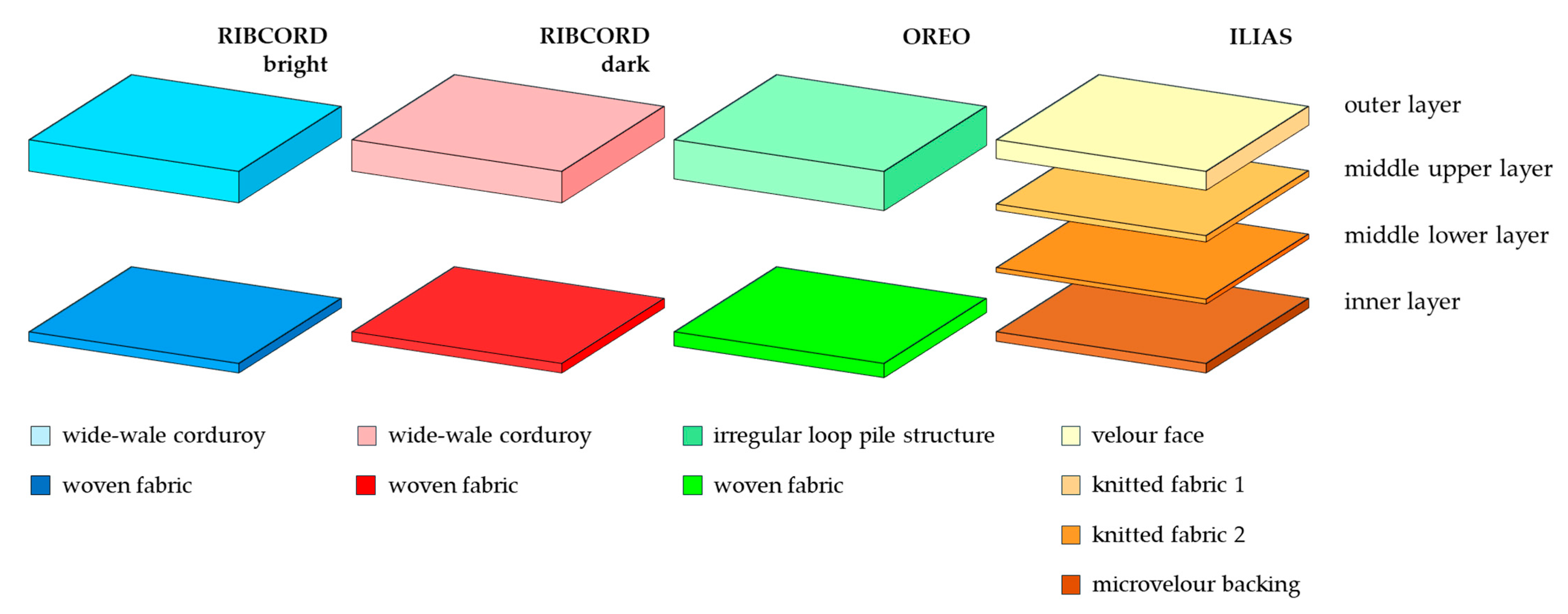
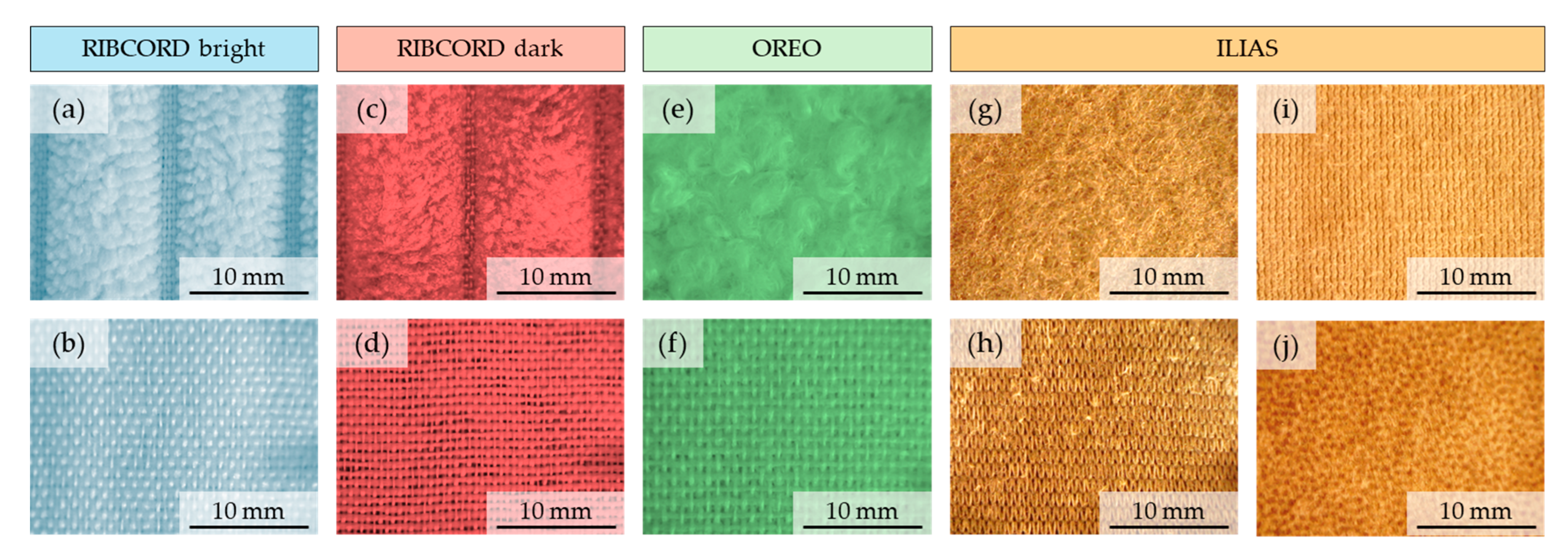


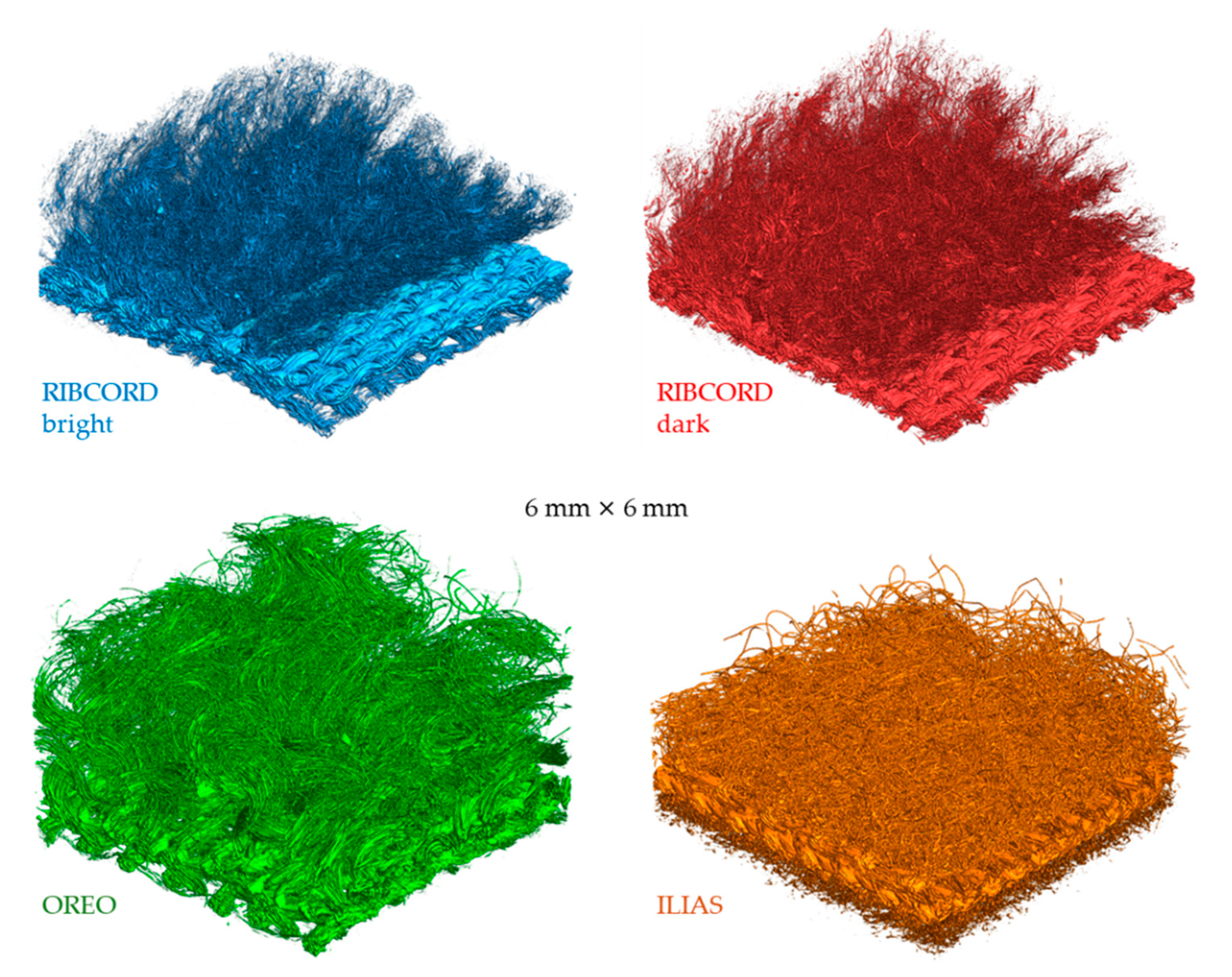
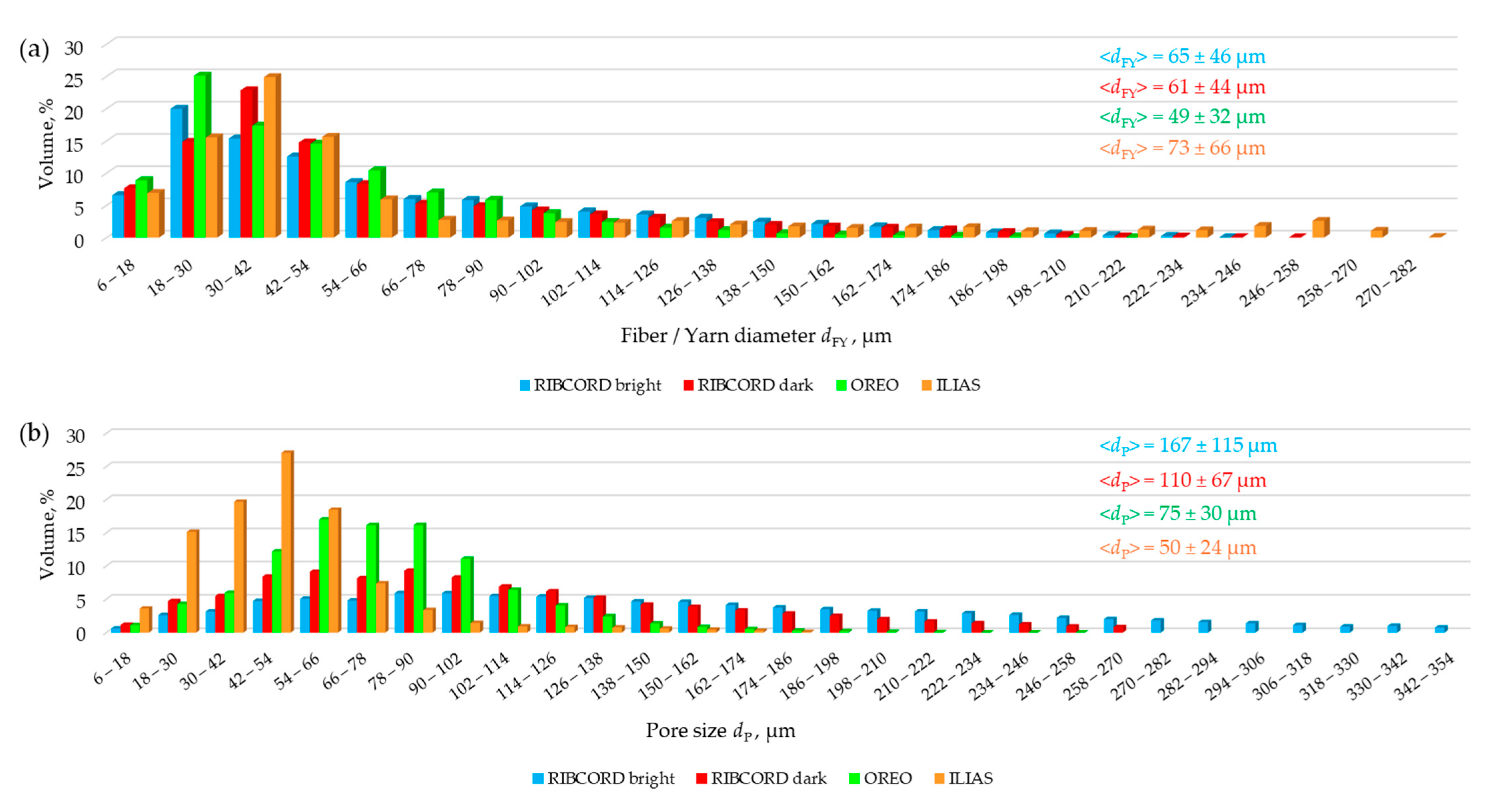

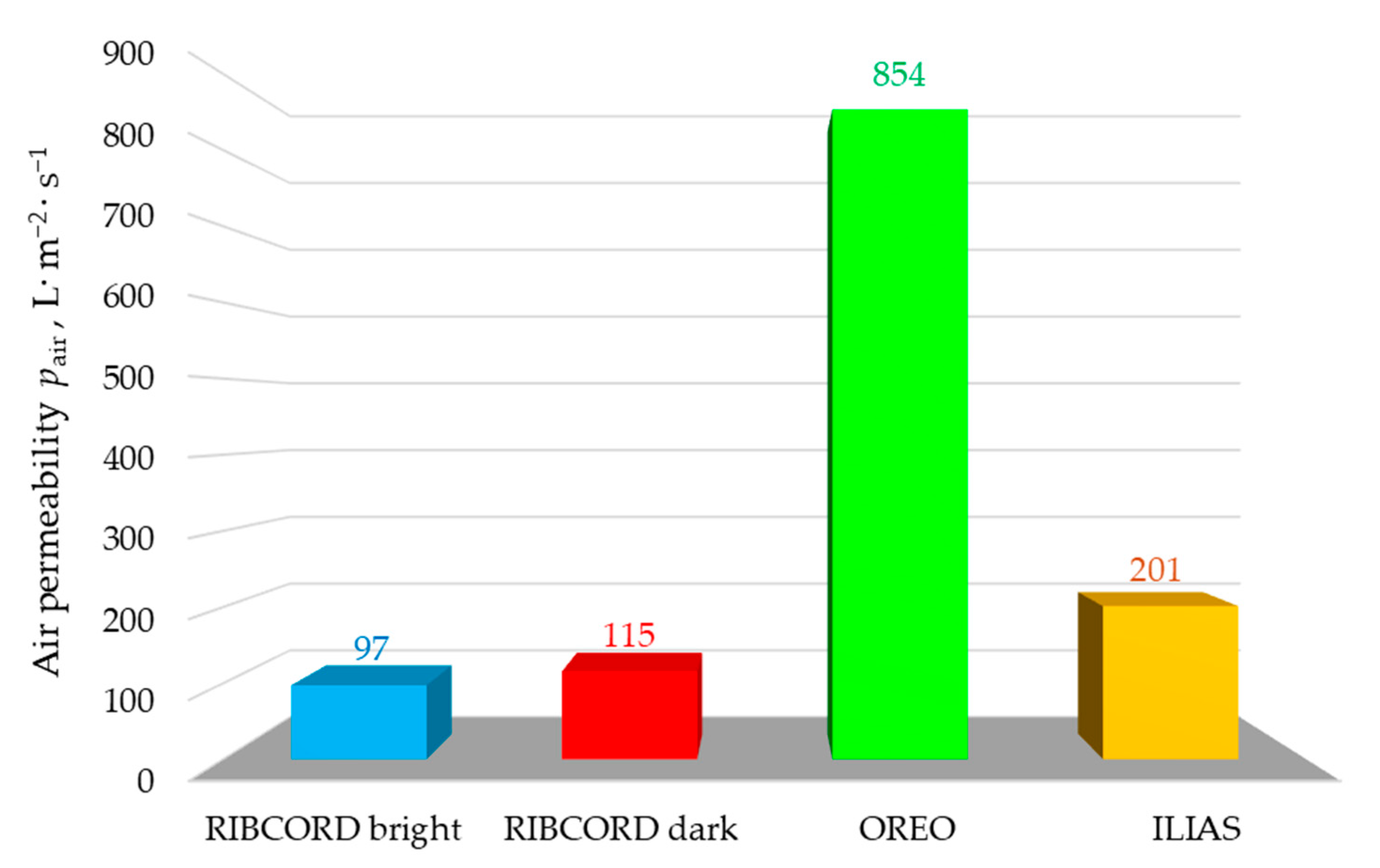



| Textile | Layer | Layer Type | Woven/Knitted Fabric Structure | Thickness [mm] | Composition | Mass Per Unit Area [g·m−2] | |
|---|---|---|---|---|---|---|---|
| RIBCORD bright | outer | wide-wale corduor | − | 2.10 | 2.70 | 88% polyester (PES), 12% polyamide (PA) | 385 |
| inner | woven fabric | plain | 0.60 | ||||
| RIBCORD dark | outer | wide-wale corduor | − | 2.10 | 2.70 | 88% polyester (PES), 12% polyamide (PA) | 385 |
| inner | woven fabric | plain | 0.60 | ||||
| OREO | outer | irregular loop pile | − | 2.50 | 3.10 | 100% polyester (PES) | 470 |
| inner | woven fabric | plain | 0.60 | ||||
| ILIAS | outer | velour face | − | 1.20 | 2.50 | 100% polyester (PES) | 405 |
| middle upper | knitted fabric 1 | single jersey | 0.40 | ||||
| middle lower | knitted fabric 2 | single jersey | 0.30 | ||||
| inner | microvelour backing | − | 0.60 | ||||
| Test Method | Device | Determined Parameters | Standard |
|---|---|---|---|
| X-ray microtomography | micro-CT SkyScan1272 | fiber thickness porosity | not applicable |
| Air permeability measurement | air permeability tester: FX 3300 | air permeability | EN ISO 9237 |
| Tensile strength | Hounsfield H10KeS universal testing machine | maximum force and elongation at maximum force of textiles | EN ISO 13934-1 |
| Abrasion and pilling resistance of fabrics by the Martindale | M235 Martindale | abrasion resistance pilling resistance | EN ISO 12947-2 EN ISO 12945-2 |
| Ignition source match flame equivalent of textiles | flammability testing apparatus | flammability | EN 1021-2:2014 |
| Textile | Layer | Layer Type | Yarn Porosity [%] | Yarn Diameter [µm] | Warp/Column Density [cm−1] | Weft/Row Density [cm−1] | ||
|---|---|---|---|---|---|---|---|---|
| Warp/Column | Weft/Row | Warp/Column | Weft/Row | |||||
| RIBCORD bright | outer | wide-wale corduor | − | − | − | − | − | − |
| inner | woven fabric | 25 | 17 | 350 | 318 | 28 | 30 | |
| RIBCORD dark | outer | wide-wale corduor | − | − | − | − | − | − |
| inner | woven fabric | 26 | 17 | 350 | 318 | 28 | 30 | |
| OREO | outer | irregular loop pile | − | − | − | − | − | − |
| inner | woven fabric | 10 | 28 | 350 | 250 | 12 | 14 | |
| ILIAS | outer | velour face | − | − | − | − | − | − |
| middle upper | knitted fabric 1 | 35 | 35 | 96 | 96 | 14 | 9 | |
| middle lower | knitted fabric 2 | 27 | 27 | 162 | 162 | 17 | 25 | |
| inner | microvelour backing | − | − | − | − | − | − | |
| Textile | Filling | Observed Phenomenon/Damage to the System | Evaluation |
|---|---|---|---|
| RIBCORD bright | Flame-retardant PU foam | After 4–5 s of exposure to the ignition flame, the system ignited—an intensifying burning process of the fabric and foam was observed. The system had to be extinguished. | Textile is flammable. |
| RIBCORD dark | Flame-retardant PU foam | After 4–5 s of exposure to the ignition flame, the system ignited—an intensifying burning process of the fabric and foam was observed. The system had to be extinguished. | Textile is flammable. |
| OREO | Flame-retardant PU foam | After 3–4 s of flame exposure, a hole melted in the fabric, exposing the PU foam. Contact of the ignition flame with the PU foam did not cause it to ignite. After the removal of the flame source, the burning process ceased spontaneously. Local damage to the system was observed as follows: seat: 10 mm × 10 mm; backrest: 70 mm × 20 mm. | Textile is self-extinguishing. Textile has a flame-retardant finish. |
| ILIAS | Flame-retardant PU foam | After 5–6 s of flame exposure, the system ignited—an intensifying burning process of the fabric and melting of the foam was observed. The system had to be extinguished. | Textiles are flammable. |
Disclaimer/Publisher’s Note: The statements, opinions and data contained in all publications are solely those of the individual author(s) and contributor(s) and not of MDPI and/or the editor(s). MDPI and/or the editor(s) disclaim responsibility for any injury to people or property resulting from any ideas, methods, instructions or products referred to in the content. |
© 2025 by the authors. Licensee MDPI, Basel, Switzerland. This article is an open access article distributed under the terms and conditions of the Creative Commons Attribution (CC BY) license (https://creativecommons.org/licenses/by/4.0/).
Share and Cite
Pinkos, J.; Puszkarz, A.K.; Rutkowski, J.; Borowińska, M. The Influence of the Upholstery Textiles Structure on Their Functional Properties. Materials 2025, 18, 5143. https://doi.org/10.3390/ma18225143
Pinkos J, Puszkarz AK, Rutkowski J, Borowińska M. The Influence of the Upholstery Textiles Structure on Their Functional Properties. Materials. 2025; 18(22):5143. https://doi.org/10.3390/ma18225143
Chicago/Turabian StylePinkos, Justyna, Adam K. Puszkarz, Jacek Rutkowski, and Martyna Borowińska. 2025. "The Influence of the Upholstery Textiles Structure on Their Functional Properties" Materials 18, no. 22: 5143. https://doi.org/10.3390/ma18225143
APA StylePinkos, J., Puszkarz, A. K., Rutkowski, J., & Borowińska, M. (2025). The Influence of the Upholstery Textiles Structure on Their Functional Properties. Materials, 18(22), 5143. https://doi.org/10.3390/ma18225143






